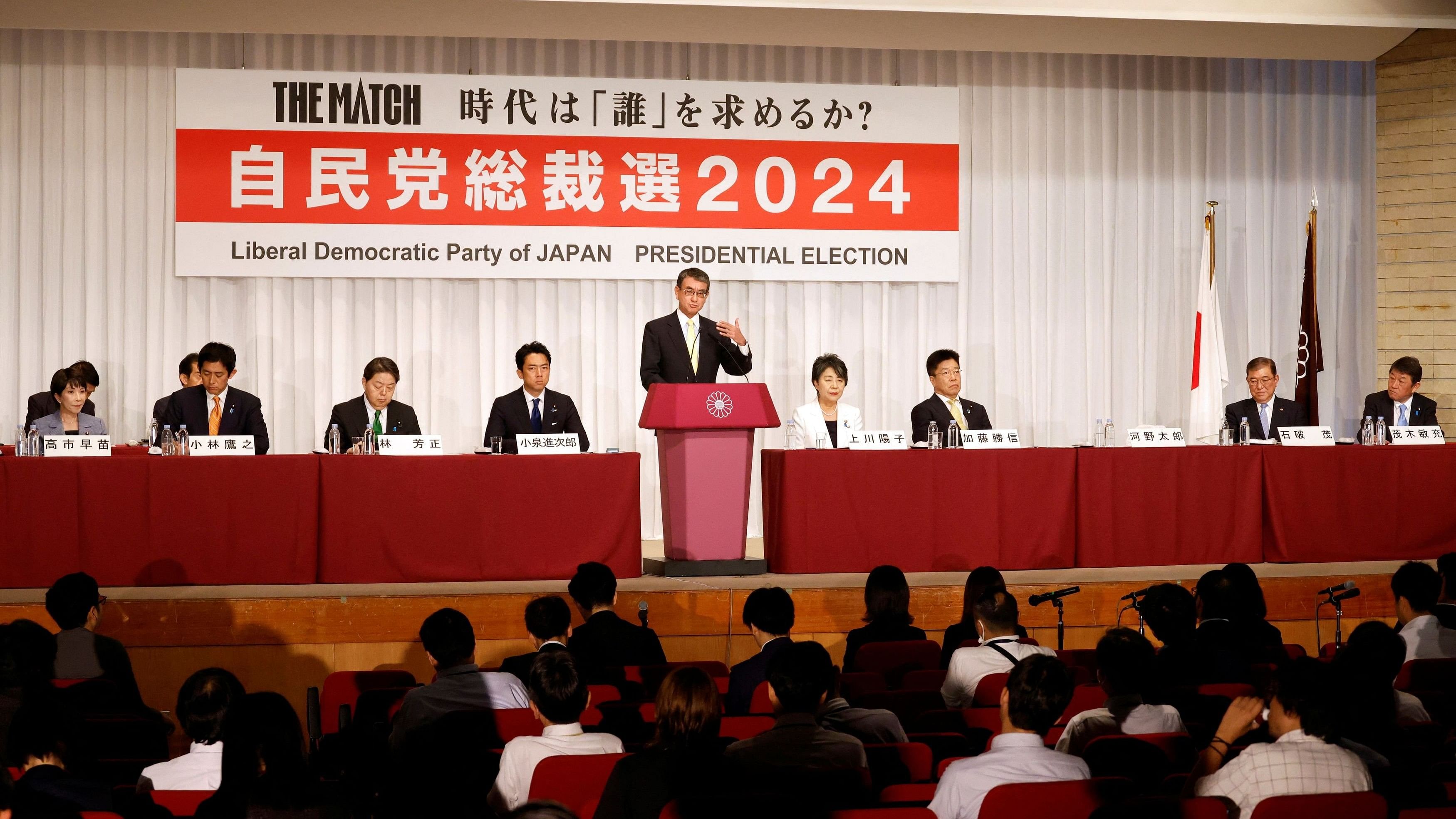
Japan's Digital Minister Taro Kono, a candidate of Japan's ruling Liberal Democratic Party presidential election, speaks during a joint press conference at the LDP headquarters in Tokyo, Japan.
Credit: Reuters Photo
By Gearoid Reidy
Japan’s ruling party wanted someone different. It might get more than it bargained for.
While nine lawmakers are contesting the race to become the country’s next leader, the field has narrowed to just three: conservative Sanae Takaichi, self-proclaimed heir to Abenomics; political scion Shinjiro Koizumi, dashing but inexperienced; and popular maverick Shigeru Ishiba, making his fifth and final bid for power.
As an alternative to the outgoing Fumio Kishida, as well as a fresh face to front the next election campaign, the Liberal Democratic Party couldn’t have asked for more. Each of the three can claim to represent a break with the past. Takaichi would be the first female prime minister. Koizumi, at just 43 years old, would represent a generational shift. And Ishiba would show acceptance of an outsider for much of his career.
But in ways not true of a Japanese leader in years, each carries serious risks. Disregard those who say the choice is unimportant so long as the LDP stay in power: the prime minister might not have the power of a US president, but from the late Shinzo Abe’s radical monetary easing to Kishida’s embrace of the US alliance, it’s undeniable that the premier can shift the LDP in hugely significant ways.
Start with Takaichi, economic-security minister and an acolyte of the easy-money policies known as Abenomics. She’s also a supporter of that wing’s hawkish foreign policies, representing her biggest risk. Improved relations with South Korea, boosted by Kishida to levels rarely bettered, may be imperiled. Those with China might worsen further, at a time when tensions with Beijing have spiked over the killing of a Japanese schoolboy and the entry of an aircraft carrier into Tokyo’s waters.
Takaichi is a defender of visits to Tokyo’s Yasukuni Shrine, which commemorates Japan’s war dead, including those convicted as war criminals — a habit she would likely seek to continue as prime minister. The last visit by a sitting leader to the divisive shrine, that of Abe in December 2013, triggered diplomatic incidents, Chinese boycotts and a rare rebuke by the US. Takaichi’s policy platform includes a pledge to create an environment where the country can “pay respect to those who have died in the service of national policy,” a thinly veiled reference to Yasukuni.
Koizumi, too, is a frequent visitor to the Tokyo shrine. His father, the reformist Junichiro Koizumi, went every year as prime minister, including, in his last days in power, on the anniversary of Japan’s defeat in World War II. The younger Koizumi has been cagier on the subject of whether he would carry on that tradition — though next year marks the significant 80th anniversary of the war’s end.
The former environment minister also brings different questions, none larger than his inexperience. On the campaign trail, that has shown as he has stumbled into obstacles of his own making. He called for labor reforms to make it easier to fire workers — a necessary change, but one which lets opponents paint him as being in the pocket of big business. He has struggled to respond to these claims, giving room for more spurious rumors (such as the false suggestion he wants to raise the pension age) to grow online — and denting his once sky-high poll ratings. And his foreign-policy experience is practically non-existent, in an environment where the 1980s anti-Japan bluster of Donald Trump might make a return to the White House.
Given Trump’s transactional nature, he might even understand Shigeru Ishiba’s talk of re-balancing Tokyo’s relationship with the US. But others in Washington might not be so sure, given Tokyo’s increasing importance in US plans to contain China. Ishiba is well-known in defense circles. But his talk of reviewing the Status of Forces Agreement to place Japan on equal terms with its security guarantor, as well as building an “Asian NATO,” are already raising eyebrows in Washington.
Some circumspect conversation around the dangers to Japan of a Chinese invasion to Taiwan, as well as comments that the country isn’t simply limited to allying with the US or moving closer to China, could rankle those who have welcomed Tokyo’s recent positioning as the US’s most crucial Asian ally.
Ishiba’s economic arguments also raise questions on his best days. I struggle to reconcile some of his reasoning — such as making the end of deflation his top priority, while simultaneously calling for Bank of Japan rate hikes to bring prices down.
The lack of an economic vision isn’t just limited to Ishiba, however. While each of the three represents a different strand of traditional LDP economic thinking — neoliberal Koizumi, who sees growth prompted by sweeping reforms; spend-heavy Takaichi, who favors a return to easing; and fiscally cautious Ishiba — their plans lack substance.
And for all the talk of issues such as allowing married couples to keep separate surnames that dominate the hustings, the next prime minister will likely survive or fall on the economy. Change can be good. But be careful what you wish for.